 The making of a molcajete is probably one of the arduous tasks in the entire culinary chain world. The process, which has remained unchanged for thousands of years, involves countless hours of an artisan, crouched over a piece of basalt volcanic rock, and slowly chipping away at it with rudimentary tools until the familiar molcajete appears.
The making of a molcajete is probably one of the arduous tasks in the entire culinary chain world. The process, which has remained unchanged for thousands of years, involves countless hours of an artisan, crouched over a piece of basalt volcanic rock, and slowly chipping away at it with rudimentary tools until the familiar molcajete appears.
The process is more 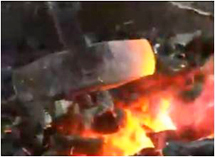 complicated than that and it really begins by making those rudimentary tools made by the artisans themselves. Forged out of
complicated than that and it really begins by making those rudimentary tools made by the artisans themselves. Forged out of  iron, the different axes they use are sharpened by fire and the help of hammers and anvil.
iron, the different axes they use are sharpened by fire and the help of hammers and anvil.
To get the raw materials the artisans 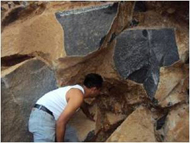 use to make the molcajetes, they have to travel to the quarries where the proper basalt volcanic rocks are found. Once the stones are selected, they begin by splitting off flat slabs. After
use to make the molcajetes, they have to travel to the quarries where the proper basalt volcanic rocks are found. Once the stones are selected, they begin by splitting off flat slabs. After  repeatedly hitting a rock at the desired width of the slab with a sharp axe, fissures begin to form and with the help of wedge point crowbar and brute force, they
repeatedly hitting a rock at the desired width of the slab with a sharp axe, fissures begin to form and with the help of wedge point crowbar and brute force, they 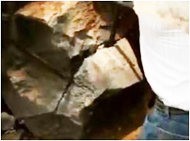 break off large flat slabs of the rock.
break off large flat slabs of the rock.
Once the slabs are on the ground, the artisans then begin to break off smaller sections, more or less the size of what the ultimate molcajete will be.
 With the slab now in smaller sections, the artisan then begins to chip away at it to make short cylinders
With the slab now in smaller sections, the artisan then begins to chip away at it to make short cylinders 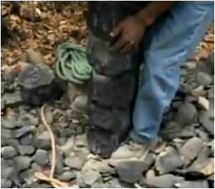 roughly the size of what the ultimate molcajete will be. Usually, this chipping process is done on the ground as they hold the section of rock between their
roughly the size of what the ultimate molcajete will be. Usually, this chipping process is done on the ground as they hold the section of rock between their 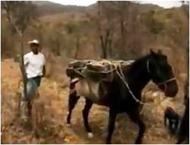 feet. Once he has formed sufficient cylinders, he ties them together in a stack, and with the help of his burro, transports them back to his work place, which is normally no more than a shady spot behind their home, to begin
feet. Once he has formed sufficient cylinders, he ties them together in a stack, and with the help of his burro, transports them back to his work place, which is normally no more than a shady spot behind their home, to begin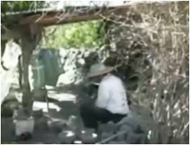 the detail work on the molcajete.
the detail work on the molcajete.
The cylinders are repeatedly trimmed by the artisan’s axes until almost perfect cylinders are formed with a diameter of the ultimate 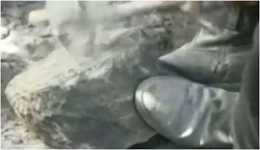 molcajete. The artisans normally start by chipping away at the rock to
molcajete. The artisans normally start by chipping away at the rock to 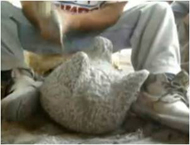 form the legs as they are the most delicate part, easily broken with the slightest wrong hit of the axe, The process takes a great deal of strength and stamina, yet hitting the rock delicately and with precision. As the process continues, all the while, sitting on the floor and holding the rock between their feet, the legs slowly begin to appear from the dust, which cover everything and turn everything grey. The legs are trimmed using narrower axes until they reach the correct dimensions and are ground smooth by the sharp instrument and delicate, but brute force.
form the legs as they are the most delicate part, easily broken with the slightest wrong hit of the axe, The process takes a great deal of strength and stamina, yet hitting the rock delicately and with precision. As the process continues, all the while, sitting on the floor and holding the rock between their feet, the legs slowly begin to appear from the dust, which cover everything and turn everything grey. The legs are trimmed using narrower axes until they reach the correct dimensions and are ground smooth by the sharp instrument and delicate, but brute force.
 The forming molcajete is then turned over, and the process of digging out the bowl section begins. The artisan carefully begins hitting the center of the mocajete with a blunter axe, which slowly begins to chip away a bowl like cavity in the rock. Eventually smaller, sharper axes are used to finely smooth the bowl.
The forming molcajete is then turned over, and the process of digging out the bowl section begins. The artisan carefully begins hitting the center of the mocajete with a blunter axe, which slowly begins to chip away a bowl like cavity in the rock. Eventually smaller, sharper axes are used to finely smooth the bowl. 
The entire piece is then given a smoothing with the fine axe, and the final product is ready!
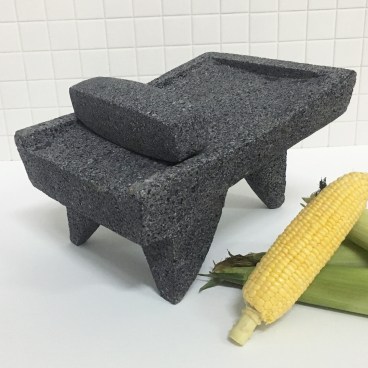





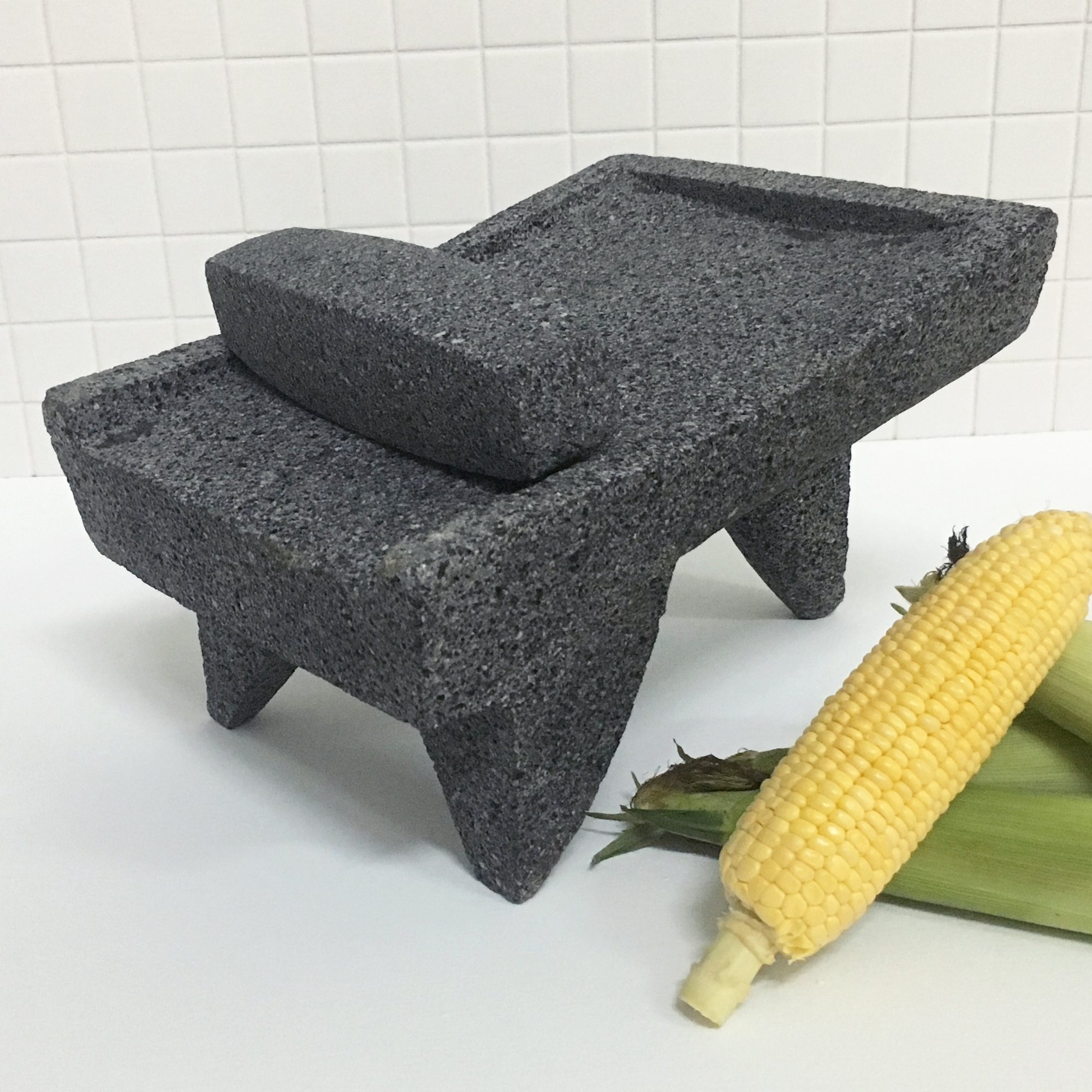


 The making of a molcajete is probably one of the arduous tasks in the entire culinary chain world. The process, which has remained unchanged for thousands of years, involves countless hours of an artisan, crouched over a piece of basalt volcanic rock, and slowly chipping away at it with rudimentary tools until the familiar molcajete appears.
The making of a molcajete is probably one of the arduous tasks in the entire culinary chain world. The process, which has remained unchanged for thousands of years, involves countless hours of an artisan, crouched over a piece of basalt volcanic rock, and slowly chipping away at it with rudimentary tools until the familiar molcajete appears. complicated than that and it really begins by making those rudimentary tools made by the artisans themselves. Forged out of
complicated than that and it really begins by making those rudimentary tools made by the artisans themselves. Forged out of  iron, the different axes they use are sharpened by fire and the help of hammers and anvil.
iron, the different axes they use are sharpened by fire and the help of hammers and anvil. use to make the molcajetes, they have to travel to the quarries where the proper basalt volcanic rocks are found. Once the stones are selected, they begin by splitting off flat slabs. After
use to make the molcajetes, they have to travel to the quarries where the proper basalt volcanic rocks are found. Once the stones are selected, they begin by splitting off flat slabs. After  repeatedly hitting a rock at the desired width of the slab with a sharp axe, fissures begin to form and with the help of wedge point crowbar and brute force, they
repeatedly hitting a rock at the desired width of the slab with a sharp axe, fissures begin to form and with the help of wedge point crowbar and brute force, they  break off large flat slabs of the rock.
break off large flat slabs of the rock. With the slab now in smaller sections, the artisan then begins to chip away at it to make short cylinders
With the slab now in smaller sections, the artisan then begins to chip away at it to make short cylinders  roughly the size of what the ultimate molcajete will be. Usually, this chipping process is done on the ground as they hold the section of rock between their
roughly the size of what the ultimate molcajete will be. Usually, this chipping process is done on the ground as they hold the section of rock between their  feet. Once he has formed sufficient cylinders, he ties them together in a stack, and with the help of his burro, transports them back to his work place, which is normally no more than a shady spot behind their home, to begin
feet. Once he has formed sufficient cylinders, he ties them together in a stack, and with the help of his burro, transports them back to his work place, which is normally no more than a shady spot behind their home, to begin the detail work on the molcajete.
the detail work on the molcajete. molcajete. The artisans normally start by chipping away at the rock to
molcajete. The artisans normally start by chipping away at the rock to  form the legs as they are the most delicate part, easily broken with the slightest wrong hit of the axe, The process takes a great deal of strength and stamina, yet hitting the rock delicately and with precision. As the process continues, all the while, sitting on the floor and holding the rock between their feet, the legs slowly begin to appear from the dust, which cover everything and turn everything grey. The legs are trimmed using narrower axes until they reach the correct dimensions and are ground smooth by the sharp instrument and delicate, but brute force.
form the legs as they are the most delicate part, easily broken with the slightest wrong hit of the axe, The process takes a great deal of strength and stamina, yet hitting the rock delicately and with precision. As the process continues, all the while, sitting on the floor and holding the rock between their feet, the legs slowly begin to appear from the dust, which cover everything and turn everything grey. The legs are trimmed using narrower axes until they reach the correct dimensions and are ground smooth by the sharp instrument and delicate, but brute force. The forming molcajete is then turned over, and the process of digging out the bowl section begins. The artisan carefully begins hitting the center of the mocajete with a blunter axe, which slowly begins to chip away a bowl like cavity in the rock. Eventually smaller, sharper axes are used to finely smooth the bowl.
The forming molcajete is then turned over, and the process of digging out the bowl section begins. The artisan carefully begins hitting the center of the mocajete with a blunter axe, which slowly begins to chip away a bowl like cavity in the rock. Eventually smaller, sharper axes are used to finely smooth the bowl. 
